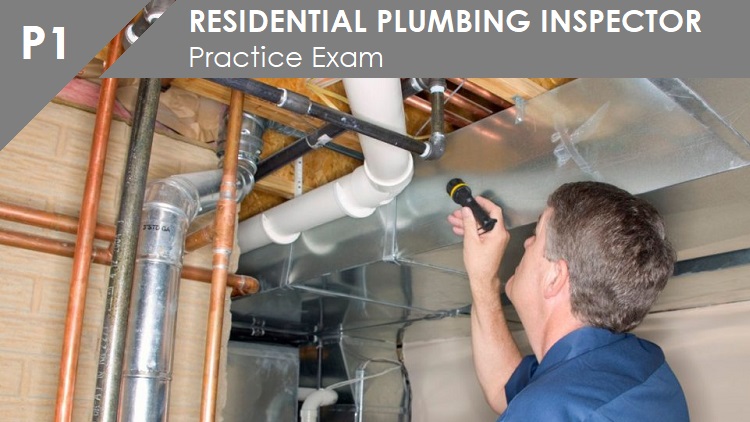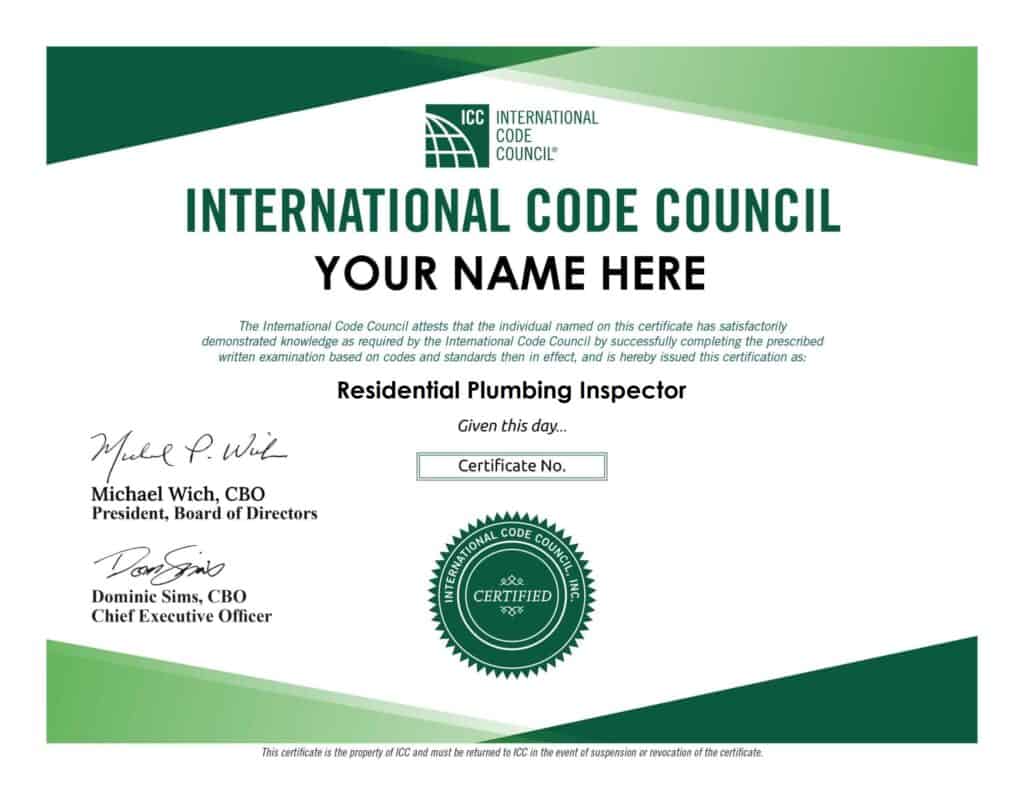
Includes 2 Practice Exams
60 Questions Each
Want to become a Certified Residential Plumbing Inspector?
The P1 Residential Plumbing Inspector Certification Exam administered by the International Code Council (ICC) tests an individuals knowledge of the International Residential Code® (IRC®).
Your first step is to know a little bit about the exam itself and what areas you should be studying for.
As a Certified Residential Plumbing Inspector you are responsible for verifying that the installation of the entire plumbing system is compliant with the codes and standards of the International Residential Code® (IRC®).
The residential plumbing inspector is also responsible for inspecting and verifying the installation and testing of piping systems, protection of piping systems and building components, the minimum required fixtures, approved materials, approved fixtures, flow rates, pressures, volume and temperature, and protection of the potable water supply and distribution system is met, verifying that all materials, joints, connections and appliances are of the approved type, and fuel gas piping combustion air and required venting is provided.
The Residential Plumbing Inspector is capable of locating specific sections in the International Residential Code in order to interpret regulations and provide accurate information to applicants, contractors, property owners, and colleagues.
P1 Residential Plumbing Inspector Exam Specifications
The exam consists of 60 multiple-choice questions. You have a time limit of 2 hours to complete the exam and it is open book meaning you can only use the code books referenced by ICC. For this exam it is the International Residential Code® (IRC®).
The code edition of the reference used should reflect the code edition of the exam you are taking. For example if you plan to take the 2021 version of the exam, you should use the 2021 International Residential Code. No work experience is required to take the exam and you must be at least 18 years of age.
The International Code Council (ICC) requires you to take the exam through the PRONTO system.
PRONTO is a new way of taking your testing exam from the comfort of your home or office. PRONTO stands for Proctored Remote Online Testing Option. For more information about the PRONTO online testing option, click here.
What does the P1 Residential Plumbing Inspector exam cover?
This exam covers 6 main areas such as:
- General Administration
- Fixtures
- Water Heaters
- Water Supply and Distribution
- Sanitary Drainage
- Vents
The following exam content outline can act as a study guide to help you study for the exam and to gain a better understanding of what the 6 main areas of the exam will cover.
General Administration | 13% |
Permits Determine when permits are required and issue permits. | 1% |
Piping System Protection Inspect all piping systems to insure protection as required from corrosion, stress and strain, freezing, and physical damage. | 3% |
Piping System Installation Inspect all piping systems for proper installation, support, sleeving, penetrations, and waterproofing of exterior openings. | 3% |
Building Component Damage Inspect building components for damage due to installation of the plumbing systems. | 3% |
Testing | 3% |
Fixtures | 8% |
Locations and Required Fixtures Inspect for proper location and the minimum required fixtures. | 2% |
Materials and Fixture Approvals Inspect for approved materials and fixture approvals. | 1% |
Installation of Fixtures Inspect for proper installation of fixtures, waste receptors, appliances, and appurtenances, including clearances, access, and sealing. | 2% |
Flow Rates and Temperatures Inspect for maximum and minimum flow rates and temperature control valves. | 2% |
Installation of Faucets, Fixture Fittings, and Accessories Inspect for proper installation of faucets, fixture fittings, and accessories. | 1% |
Water Heaters | 12% |
Use and Installation of Materials and Appliances Inspect for proper use and installation of materials and check for appliance approval. | 2% |
Service and Distribution and Piping Inspect for clearances, locations, protection, pans, and seismic restraint. | 3% |
Valving, Discharge Piping, and Thermal Expansion | 4% |
Fuel Gas Piping, Combustion Air, and Venting | 3% |
Water Supply and Distribution | 22% |
Materials Joints and Connections Inspect for approved materials, joints, and connections. | 3% |
Service and Distribution Piping Inspect the service and distribution piping for proper installation of cold and hot water delivery, identification, sizing, and valving. | 5% |
Potable Water Supply and Protection | 7% |
Nonpotable Water Supply and Protection | 2% |
Pressure and Volume | 3% |
Potable Water and Water Treatment | 2% |
Sanitary Drainage | 23% |
Materials, Fittings, Joints, and Connections Inspect for approved materials and use of proper fittings, joints, and connections. | 4% |
Building Drains, Sewers, Branches, and Stacks | 8% |
Backwater Valves, Sumps, Ejectors, and Cleanouts | 3% |
Traps | 5% |
Indirect Waste Systems Inspect indirect waste systems for air breaks or air gaps. | 3% |
Vents | 22% |
Materials, Joints, Connections, and Grades Inspect for approved materials, joints, connections, and proper grades. | 5% |
Sizing Inspect for the proper sizing of the venting system. | 6% |
Requirements, Methods, and Installation Inspect for the minimum venting requirements, methods, and installation. | 11% |
What do you get when you pass the P1 Residential Plumbing Inspector exam?
Certification
Bragging rights! Well actually you will receive a pass letter the same day right after your exam. You will have a certification number assigned to you so that if someone were to search for a certified professional within the ICC website, your name will come up!
In addition to being a Certified Residential Plumbing Inspector (Yayyy!) you will receive a wall certification that looks like this…

Need Practice?
Why not try our P1 Residential Plumbing Inspector Practice Exam?
Want to test your knowledge of how well you know the code? Or maybe just get a feel for the exam?
Try out our Practice Exam for the P1 Residential Plumbing Inspector Certification Exam!
This practice exam is designed for those who are looking to take the 2021 or 2018 version of the P1 Residential Plumbing Inspector Certification Exam through the International Code Council (ICC). These practice exams are intended to help you prepare for the actual exam by helping you navigate through the code book to familiarize yourself with the specific code sections. They will test your knowledge on the exam content areas covered to improve your chances of passing the certification exam.
This is a great way to prepare yourself for the actual exam administered by ICC. Every building code professional knows that the key to passing the ICC exams is to do practice problems. Don’t just take the exam purely on experience alone. Let this resource get you focused on realistic problems built around the exam content being covered.

Includes 2 Practice Exams
60 Questions Each
Happy Test Taking!
Related Articles to Read:
